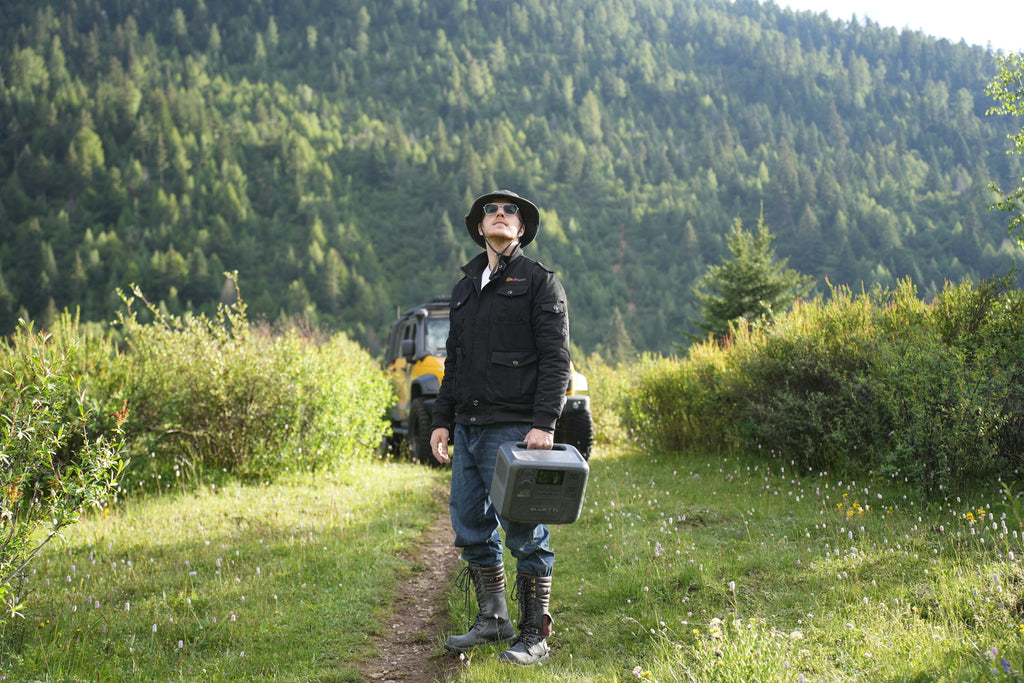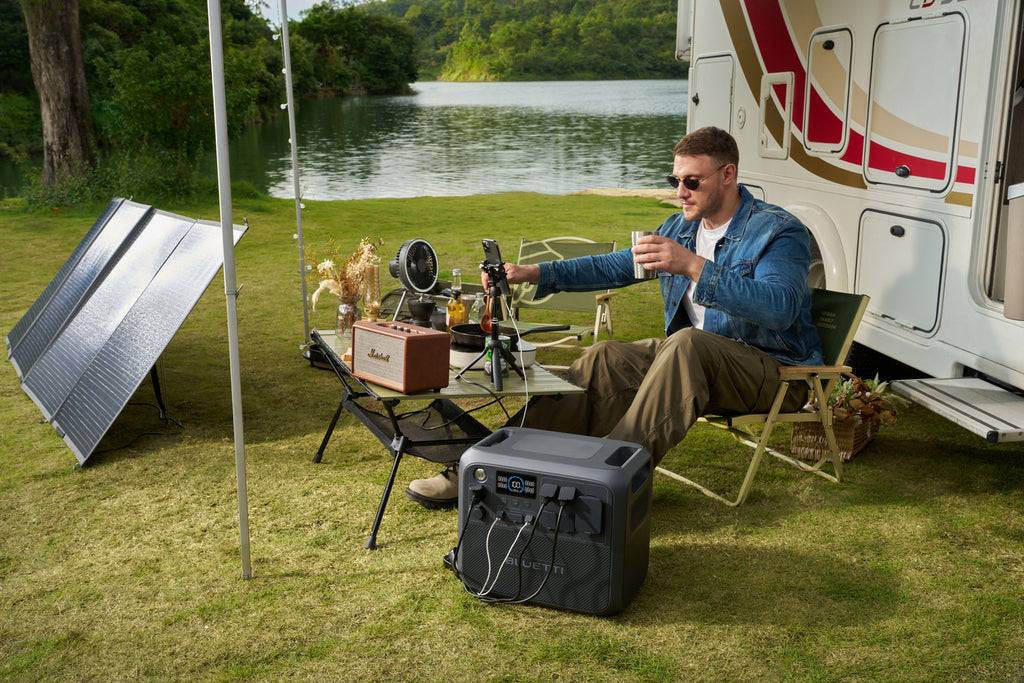Having a backup power system is a boon, especially during prolonged power outages. While you can use a conventional standby generator, a portable power station can be an alternative as it does not require specialized installation or produce harmful gasses. But does it meet your power needs? Is it a viable option? Let’s find out.
What is A Portable Power Station?

Portable power stations are portable power suppliers for emergency needs in your home or outdoor activities. They come with different outputs such as AC, USB-C, and USB-A, ensuring you can connect different devices with ease.
They can also be charged using different power sources. Whether you want to use an AC power outlet, a lead-acid battery or your car, there’s a port for either. Portable power stations come in different sizes and shapes as well as chemistries.
Generally, most companies use lithium batteries with the most common being lithium iron phosphate (LFP) and nickel manganese cobalt (NMC). Of the two, LFP is the most reliable and efficient. It also has a longer lifespan.
As you’d expect, portable power stations come in different capacities with larger options having a capacity of up to 25 kWh. The best part is that most stations’ capacity can be expanded by adding extra batteries.
When connected to your home’s solar system with an integrated unit, portable power stations become a reliable source of power in the event of a prolonged power outage.
Pros and Cons of A Portable Power Station
So what are the advantages and disadvantages of using a portable power station? Let’s find out.
Pros
- Safe to Use
Portable power stations are some of the safest sources of power on the market. Unlike conventional generators that produce harmful fumes when running, portable power stations provide sustainable power.
That is, they do not produce gasses that pollute the environment and are harmful to your health. Furthermore, they do not have moving parts that might cause bodily harm when running.
- Low Maintenance
They require little to no maintenance once installed. Since they have no moving parts, you don’t have to worry about lubricating or replacing some of their parts. There’s no maintenance needed besides cleaning the station.
- Quiet Operation
This is one of the reasons why most residential areas permit the use of portable power stations; they are quiet. Whether you install them in your house or basement, there’ll be minimal noise interruption if any. So if you want to have it quiet during power outages, consider buying a portable power station.
- Lightweight
Unlike conventional standby generators, portable power stations are lightweight and portable meaning you can move them from room to room with ease. Furthermore, you can always transport them to your camping site. The beauty of portable generators is their compact design. They can fit in tight space and operate without overheating
Cons
- Limited Capacity
Most portable power stations have limited capacity, meaning they cannot power most of your appliances simultaneously. And to achieve this, you’ll need to buy extra batteries or connect to a robust solar system. Small stations can only recharge small devices such as smartphones and laptops but cannot power large appliances.
- Longer Charging Time
Charging portable power stations with solar panels may be time-consuming. Some might take 8 hours while others might take 10 hours depending on the weather conditions. To overcome this limitation you may recharge your station using an AC outlet or lead-acid battery.
- High Initial Cost
Another disadvantage is the high initial cost. Some of the most reliable power stations are pricey, costing more than $8,000. Fortunately, you’ll recoup the cost in the long run.
Is It Worth It to Buy a Portable Power Station?

Yes, you should buy a portable power station. First, a portable power station becomes a reliable source of backup power when there’s a prolonged power outage. It provides ample uninterrupted power to run your appliances.
A portable power station doesn’t require professional installation, meaning you can install it by yourself. Just plug it into an electrical outlet and you are good to go. And if it might require a technician, the task will be minimal.
Another reason to buy a portable power station is that you can use it for different needs. Besides providing backup power, a portable power station can be used to keep lights on and equipment running while camping and other outdoor activities.
Related articles: What Is the Best Portable Power Station to Buy in 2024?
Is a Portable Power Station Better Than an Inverter?
How Do I Know What Size Portable Power Station I Need?
Tips for Choosing a Best Portable Power Station
So, how can you choose the right portable power station? Here are aspects to consider.
- Battery Technology
One major aspect you should consider when choosing a portable power station is the battery technology. The battery type will influence the weight, size, charging speed, and cost of the power station.
The most common types are lithium-ion and lead-acid batteries. Lithium-ion batteries also come in different chemistries with lithium iron phosphate being the most reliable, which is synonymous with BLUETTI portable power stations.
While lead-acid batteries are cheaper, they are bulkier and less reliable.
- Battery Capacity
Another important aspect to consider is the battery capacity. The bigger the capacity the more the devices it will power. So, if you plan to power many devices, buy a power station with a larger capacity. Here, you should look out for metrics such as kWh (kilowatt-hour), Wh(Watt hour), and Ah (Amp hour).
- Running and Starting wattage
Also, consider the running and starting wattage of a portable power station. While most power stations are used to charge small devices such as laptops and smartphones, they can be used to run appliances such as refrigerators and electric fans.
And such large appliances have a starting and running wattage. Your portable power station should have ample capacity to jump-start and then run such appliances.
- Power Output and Input Ports
Finally, you should get a portable power station with numerous output and input ports. Buy one with multiple USB and USB-C ports, allowing you to charge numerous devices simultaneously. Also, consider the output ports. Ideally, get one with solar charging, DC, and AC ports.
Best New BLUETTI Portable Power Stations for 2024
BLUETTI AC2A Portable Power Station | 300W 204Wh
If you are looking for a small power station to charge your devices or provide power when camping, consider buying this model. Having a 300W continuous power, it can recharge most of your appliances quite quickly.
The station has a 204.8 Wh capacity, enough to run a toaster, laptop, or juice extractor for at least one hour. And recharging it is a bliss since you can use your car, solar panels, or an AC outlet. The station takes 45 minutes to charge up to 80%. As a LiFePO4 power station, you will enjoy over 3,000 charge cycles.
BLUETTI AC70 Portable Power Station | 1000W 768Wh

Another power station to consider is the BLUETTI AC70. This model boasts of a 1,000W rated power and 2,000W lifting power. This means it can power large appliances such as refrigerators and heating systems. With a 768Wh capacity, it can provide ample power to run appliances such as a coffee maker and toaster for hours.
And thanks to its Turbo Charging feature, it takes 45 minutes to recharge it to 80%. So, it will take less than an hour to recharge it fully. It also has a fast charging solar system that enables it to fully charge within two hours.
For convenience, the power station comes with 7 outlets so you can charge your phone, laptop, and other devices. You are also provided with an app for remote control and monitoring.
BLUETTI AC200L Portable Power Station | 2,400W 2,048Wh
If you are looking for a high-capacity portable power station, this is your best bet. It has a 2,048Wh capacity ideal for running most of your household appliances. Whether you want to power your refrigerator, kettle, or coffee maker, you can rest assured it will provide ample power.

Its fast charging feature allows for 2,400W AC input and 1,200W solar input. It means it will take a few hours to fully charge the station. You can even expand its capacity to 8,192Wh using extra batteries.
There are 6 ways to recharge the power station ranging from solar panels to AC outlets. And thanks to the over 3,000 charge cycles, you can use the BLUETTI AC200L for up to 10 years.
Who Should Buy a Portable Power Station?
A portable power station is an ideal equipment for outdoor enthusiasts such as backpackers, hikers, and campers. It allows them to keep their devices charged, power the lights, and run small appliances like blenders.
A portable power station is also ideal for people who live in areas prone to prolonged power outages. As mentioned, large portable power stations can provide ample power to light your home and run large appliances for an extended period.
And if you want to live off grid, a portable power station will come in handy. With extra batteries, you can use the power station for days on a single charge. However, make sure you have a reliable solar charging system to ensure uninterrupted power supply.
Final Thoughts
As you can see, buying a power station is worth every penny. Not only does it provide backup power incase of a power outage but can also be used for outdoor activities. Consider aspects such as battery type, capacity, and brand when buying one for your needs. If you need a well-performing station, consider buying from BLUETTI.







































































